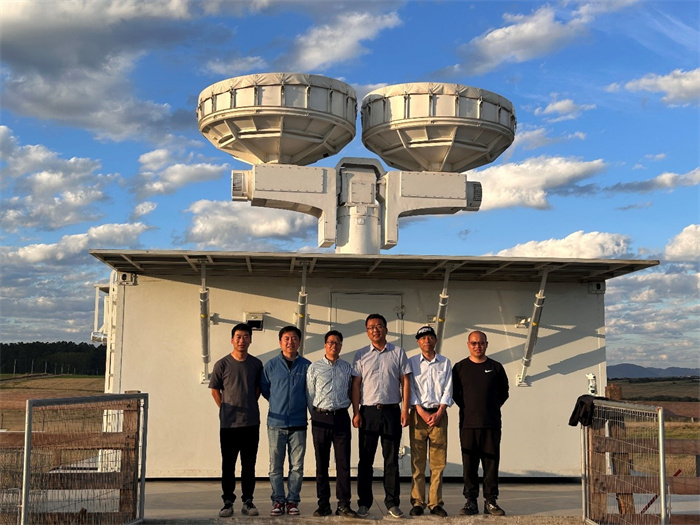Santa Maria, Brazil, has witnessed the successful installation of an exceptional state-of-the-art dual-wavelength cloud/rain measurement radar, adding a vital tool to its scientific repertoire. From May 26 to June 19, engineers from the Institute of Atmospheric Physics,with the logistic support of the South American Space Weather Laboratory, in collaboration with the Federal University of Santa Maria, Brazil, joined forces to establish the Santa Maria Atmospheric Science Observatory in South America.
The team and radar
During the meticulous installation and trial operation of the radar equipment, experts from the Chinese Academy of Sciences, the South American Space Weather Laboratory, and the Federal University of Santa Maria engaged in comprehensive discussions. Their primary focus revolved around the future operation and maintenance of the radar system, as well as the exploration of possibilities for scientific research advancements and talent development in the field of atmospheric science.
This significant achievement serves as a remarkable milestone in the ongoing international cooperation between China and Brazil in space weather and atmospheric science. The installation of the state-of-the-art dual-wavelength and dual-polarization Doppler cloud/rain radar, developed entirely in China, in the southern region of Santa Maria marks a noteworthy stride in enhancing atmospheric research capabilities. As the radar system embarks on its trial observation phase, scientists anticipate its transformative impact on cloud and rain studies.
Under the leadership of Academician LYU Daren, this ambitious project falls under the second phase of the construction task assigned to the China-Brazil Space Weather Joint Laboratory, housed within the South American Space Weather Laboratory. The primary objective of this phase is to explore the intricate processes within the atmosphere that influence space weather and deepen our understanding of their implications. By employing cutting-edge research methodologies, including the detection and analysis of atmospheric phenomena, scientists aim to unravel the mysteries surrounding their interaction with space weather dynamics.
The establishment of an atmospheric radar observatory in Brazil, an area where China's involvement in atmospheric research collaboration had been previously limited, signifies a significant breakthrough. This achievement opens doors to high-resolution ground-based observations, allowing researchers to gather crucial data on various atmospheric elements. Collaborating closely with Brazilian scientists, the team plans to conduct long-term systematic observations and analyze data on cloud systems, convective processes, and high clouds in the Santa Maria region, situated in the southern hemisphere's mid-latitude zone. Through these comprehensive investigations, scientists seek to unravel the complex and multi-scale features of cloud systems and convective cloud processes unique to this region.
The president of Federal University of Santa Maria welcomes Chinese delegation.
Scientifically, the radar system's deployment plays a pivotal role in understanding the bottom-up processes that shape space weather phenomena. By gaining innovative insights into the coupling of convective cloud systems and high clouds within the upper and lower atmosphere, this research promises to significantly advance our understanding of global atmospheric processes. Furthermore, in conjunction with existing observations, such as those conducted in China's Tibetan Plateau, this project enables a comprehensive examination of global weather dynamics.
At the heart of this cutting-edge project lies the domestically developed X/Ka dual-wavelength dual-polarization Doppler cloud/rain radar. Jointly developed by the Institute of Atmospheric Physics of the Chinese Academy of Sciences and Nanjing Nrite Industrial Co., Ltd., this advanced radar system employs the X-band for rain measurement and the Ka-band for cloud detection. Its dual-wavelength capabilities allow for simultaneous and continuous all-weather observations, enabling researchers to unravel the intricate evolution of non-precipitation clouds, weak precipitation clouds, stratiform cloud precipitation, and convective precipitation. By acquiring precise spatiotemporal data on various physical parameters, the radar system paves the way for unprecedented research opportunities, fueling groundbreaking insights into weather evolution processes.
The successful installation and operation of the dual-wavelength radar system signify a remarkable technological accomplishment. Moreover, this achievement strengthens the foundation of international cooperation and research between China and South America. As the Santa Maria Atmospheric Science Observatory takes flight, anticipation mounts as scientists prepare to unlock the secrets of the skies, contributing to a comprehensive understanding of atmospheric science on a global scale.


